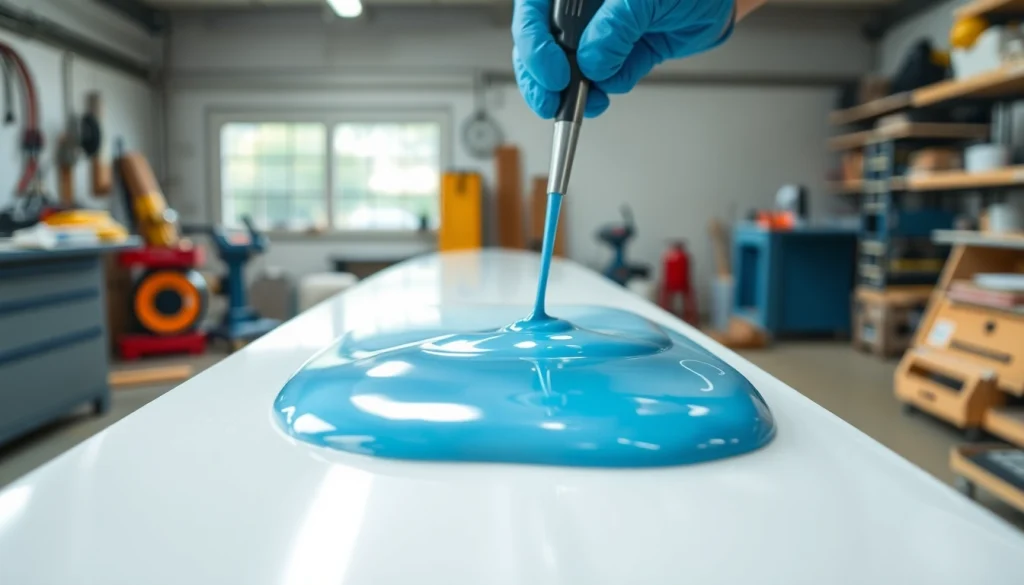Understanding Laminating Resin: Applications, Benefits, and Best Practices

What is Laminating Resin?
Laminating resin is a specialized type of resin used primarily in the fabrication of composite materials. It plays a critical role in reinforcing structures with layers of fiberglass cloth or other reinforcing materials. The application of laminating resin allows manufacturers and hobbyists alike to create robust and lightweight components, especially in industries like marine, automotive, and construction.
Definition and Types of Laminating Resin
The term laminating resin refers to a variety of synthetic resins, largely categorized into two main types: polyester and epoxy. While both serve similar purposes, their chemical properties, curing times, and physical characteristics differentiate them significantly.
- Polyester Laminating Resin: Often used in the marine industry, this type is known for its strength and affordability. It usually requires a catalyst for curing and is diluted with styrene to enhance its viscosity and speed of curing.
- Epoxy Laminating Resin: Renowned for its superior adhesion, flexibility, and resistance to environmental factors, epoxy is often the choice for applications requiring a high degree of durability. It typically has a longer cure time compared to polyester.
Key Characteristics of Laminating Resin
The effectiveness of laminating resins lies in their distinctive characteristics, which include:
- Adhesion: Strong bonding capabilities that ensure layers adhere seamlessly.
- Viscosity: Availability in multiple viscosities allows for appropriate application based on the project needs.
- Curing Time: Both polyester and epoxy resins have distinct curing times, affecting project timelines.
- Temperature Resistance: Their ability to resist heat can vary, making them suitable for different environmental conditions.
- Chemical Resistance: Essential for projects exposed to corrosive substances.
Common Uses of Laminating Resin
Laminating resin’s versatility enables its application in numerous fields, including:
- Marine Construction: Used in the building of boats, yachts, and other vessels.
- Automotive Parts: Employed in creating lightweight composite body panels.
- Furniture Manufacturing: Used for reinforcing structures and creating aesthetic finishes.
- Repair Work: Ideal for fixing damaged composite structures due to its strong bonding capabilities.
Benefits of Using Laminating Resin
The adoption of laminating resin in various applications provides several notable benefits:
Durability and Strength of Laminating Resin
Laminating resin significantly enhances the strength and durability of composite materials. By embedding fibers in layers, the resin distributes stress evenly, thereby improving impact resistance and structural integrity. This characteristic is especially crucial in applications where materials face extreme conditions, such as marine and automotive environments.
Cost-Effectiveness of Laminating Resin
When compared to traditional materials, laminating resin offers a cost-effective solution for creating strong and lightweight structures. The longevity and reduced maintenance needs of composite materials can lead to lower overall costs in projects. The initial investment in high-quality laminating resin is offset by the savings on repairs and replacements over time.
Environmental Factors and Laminating Resin
Laminating resin can be formulated to withstand various environmental factors, including UV exposure, moisture, and temperature fluctuations. This resilience ensures that finished products maintain performance over time, even in challenging settings. Moreover, advancements in formulations have led to the development of eco-friendly laminating resins that aim to reduce harmful emissions and environmental impact during production.
How to Choose the Right Laminating Resin
Selecting the appropriate laminating resin for a specific project is crucial for achieving the desired results. Here are several factors to consider:
Different Projects and Their Laminating Resin Needs
Different applications necessitate different properties from laminating resin. For example, a project requiring high strength and rigidity may benefit from epoxy, while a budget-sensitive project might be better suited to polyester resin. Understanding the project specifications is the first step in making the right choice.
Viscosity and Gel Time Considerations
The viscosity of laminating resin affects its application process, with low-viscosity resins allowing for easier penetration into fabrics. Gel time is another crucial factor that dictates how long the resin remains workable before it begins to cure. Project timelines and environmental conditions (like temperature and humidity) should influence these selections.
Environmental Conditions for Laminating Resin Application
Understanding environmental conditions, such as humidity and temperature, is essential when working with laminating resins, as these factors affect curing times and overall performance. For optimal results, application should be carried out within specified temperature ranges, and high humidity environments should be avoided whenever possible.
Best Practices for Application of Laminating Resin
Surface Preparation for Laminating Resin
The success of laminating resin applications hinges on proper surface preparation. Surfaces must be clean, dry, and free from contaminants such as oil, dust, or moisture. Multiple techniques, including sanding and solvent wiping, can help ensure that surfaces are optimally prepared for resin adhesion.
Application Techniques for Laminating Resin
Application methods such as brush, roller, and spray are common. The choice depends on the specific project and desired finish. It is crucial to apply the resin evenly, ensuring complete saturation of any supporting fabrics. Following manufacturer’s instructions on mixing ratios and application techniques will yield the best results.
Post-Application Care of Laminating Resin
Once applied, laminating resin requires post-application care. This includes providing a controlled curing environment free from moisture and extreme temperatures. Monitoring the curing process and allowing adequate time for the resin to achieve its full strength is essential for durability. After curing, surfaces can be finished as required, including sanding and painting if necessary.
Future Trends in Laminating Resin Technology
The landscape of laminating resin technology is continuously evolving, with several anticipated trends shaping the future:
Innovations in Laminating Resin Materials
Research and development aim to create laminating resins that are stronger, lighter, and more environmentally friendly. Innovative formulations may include new additives that enhance performance characteristics while reducing reliance on volatile organic compounds (VOCs).
Eco-Friendly Laminating Resin Options
As sustainability becomes increasingly important, more manufacturers are focusing on the development of eco-friendly laminating resin options. These formulations aim to minimize environmental impact without compromising structural performance.
Market Predictions for Laminating Resin Demand
With ongoing advancements in manufacturing processes and increased demand for lightweight materials, market predictions indicate a growing need for laminating resin across various industries. The continued expansion of composites in sectors like aerospace, automotive, and construction suggests a robust future for this versatile material.







